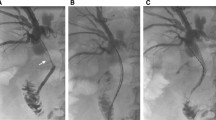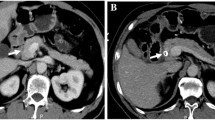Abstract
Background
The purpose of this research was to evaluate the safety and efficacy of a self-expandable metallic stent (SEMS) combined with iodine-125 (125I) seeds in the treatment of Bismuth type I or II malignant biliary obstruction (MBO).
Methods
The clinical data of 74 cases of MBO treated with percutaneous SEMS combined with 125I seeds (combination group) and 81 cases of MBO treated with SEMS implantation alone (control group) in our hospital from January 2015 to December 2019 were retrospectively analyzed. The short-term and long-term efficacy of the two groups were compared. Multivariate Cox regression analysis was used to analyze the factors affecting the surgical efficacy and survival rate.
Results
The liver blood test results of both groups improved at one week and one month post-stent insertion. No significant difference was established in the short-term efficacy or complications between the two groups (P = NS). Improved stent patency was observed in the combined group, 9.01 ± 4.38 months versus 6.79 ± 3.13 months, respectively (P < 0.001). Improved survival was also noted in the combined group 12.08 ± 5.38 months and 9.10 ± 4.16 months, respectively (P < 0.001). Univariate and multivariate analyses showed that the type of biliary stent and liver metastasis were independent factors affecting survival.
Conclusion
The implementation of SEMS combined with 125I seeds resulted in significantly longer stent patency and survival times than that of SEMS implantation alone, which is thus worthy of clinical promotion and application.



Similar content being viewed by others
References
Fernandez Y, Viesca M, Arvanitakis M (2019) Early diagnosis and management of malignant distal biliary obstruction: a review on current recommendations and guidelines. Clin Exp Gastroenterol 12:415–432
Moole H, Bechtold M, Puli SR (2016) Efficacy of preoperative biliary drainage in malignant obstructive jaundice: a meta-analysis and systematic review. World J Surg Oncol 14(1):182
Boulay BR, Birg A (2016) Malignant biliary obstruction: from palliation to treatment. World J Gastrointest Oncol 8(6):498–508
Zhou C, Li H, Huang Q et al (2020) Biliary self-expandable metallic stent combined with Iodine-125 seeds strand in the treatment of hilar malignant biliary obstruction. J Int Med Res 48(4):300060519887843
Dumonceau JM, Tringali A, Papanikolaou IS et al (2018) Endoscopic biliary stenting: indications, choice of stents, and results: European Society of Gastrointestinal Endoscopy (ESGE) Clinical Guideline—Updated October 2017. Endoscopy 50(9):910–930
Mukai S, Itoi T, Baron TH et al (2017) Indications and techniques of biliary drainage for acute cholangitis in updated Tokyo Guidelines 2018. J Hepatobiliary Pancreat Sci 24(10):537–549
Hasimu A, Gu JP, Ji WZ et al (2017) Comparative study of percutaneous transhepatic biliary stent placement with or without iodine-125 seeds for treating patients with malignant biliary obstruction. J Vasc Interv Radiol 28(4):583–593
Kim JY, Ko GB, Lee TH et al (2017) Partially covered metal stents may not prolong stent patency compared to uncovered stents in unresectable malignant distal biliary obstruction. Gut Liver 11(3):440–446
Won JH, Lee JD, Wang HJ et al (2005) Effects of a holmium-166 incorporated covered stent placement in normal canine common bile ducts. J Vasc Interv Radiol 16(5):705–711
Zhou WZ, Fu YM, Yang ZQ et al (2019) Study of percutaneous stent placement with iodine-125 seed strand for malignant biliary obstruction. Cardiovasc Interv Radiol 42(2):268–275
Li S, Li B, Li L et al (2020) The efficacy of the combination of percutaneous transhepatic biliary drainage and 125I stranded seeds for malignant bile duct obstruction treatment. J Contemp Brachyther 12(3):225–232
Song S, Jin H, Cheng Q et al (2022) Local palliative therapies for unresectable malignant biliary obstruction: radiofrequency ablation combined with stent or biliary stent alone? An updated meta-analysis of nineteen trials. Surg Endosc 36(8):5559–5570
Almadi MA, Barkun A, Martel M (2017) Plastic vs. self-expandable metal stents for palliation in malignant biliary obstruction: a series of meta-analyses. Am J Gastroenterol 112(2):260–273
Acu B, Kurtulus OE (2018) Feasibility and safety of percutaneous transhepatic endobiliary radiofrequency ablation as an adjunct to biliary stenting in malignant biliary obstruction. Diagn Interv Imaging 99(4):237–245
Takamura A, Saito H, Kamada T et al (2003) Intraluminal low-dose-rate 192Ir brachytherapy combined with external beam radiotherapy and biliary stenting for unresectable extrahepatic bile duct carcinoma. Int J Radiat Oncol Biol Phys 57(5):1357–1365
Cao G, Cao H, Liu J et al (2013) One-channel double stent implantation for hilar biliary obstructions. Exp Ther Med 5(4):1179–1183
Xu X, Li J, Wu J et al (2018) A systematic review and meta-analysis of intraluminal brachytherapy versus stent alone in the treatment of malignant obstructive jaundice. Cardiovasc Interv Radiol 41(2):206–217
Pang Q, Zhou L, Hu XS et al (2019) Biliary stenting alone versus biliary stenting combined with 125I particles intracavitary irradiation for the treatment of advanced cholangiocarcinoma. Sci Rep 9(1):11348
Wang T, Liu S, Zheng YB et al (2017) Clinical study on using 125I seeds articles combined with biliary stent implantation in the treatment of malignant obstructive jaundice. Anticancer Res 37(8):4649–4653
Lu J, Guo JH, Zhu HD et al (2017) Safety and efficacy of irradiation stent placement for malignant portal vein thrombus combined with transarterial chemoembolization for hepatocellular carcinoma: a single-center experience. J Vasc Interv Radiol 28(6):786-794.e3
Huo X, Wang H, Yang J et al (2016) Effectiveness and safety of CT-guided (125)I seed brachytherapy for postoperative locoregional recurrence in patients with non-small cell lung cancer. Brachytherapy 15(3):370–380
An R, Zhang H, Yu J et al (2021) Self-expandable metallic stent with 125I seed strand in malignant biliary obstruction: a self-made delivery system and novel implantation method. Ann Transl Med 9(24):1774
Wu JZ, Li CL, Shi HB et al (2022) Hepatic arterial infusion chemotherapy following simultaneous metallic stent placement and iodine-125 seed strands for advanced cholangiocarcinoma causing malignant obstructive jaundice: a propensity score matching study. Jpn J Radiol 40(4):396–403
Zhou X, Zhang W, Dou M et al (2022) 125I seeds inhibit proliferation and promote apoptosis in cholangiocarcinoma cells by regulating the AGR2-mediated p38 MAPK pathway. Cancer Lett 524:29–41
Lu J, Guo JH, Zhu HD et al (2017) Palliative treatment with radiation-emitting metallic stents in unresectable Bismuth type III or IV hilar cholangiocarcinoma. ESMO Open 2(4):e000242
Zhu HD, Guo JH, Huang M et al (2018) Irradiation stents vs. conventional metal stents for unresectable malignant biliary obstruction: a multicenter trial. J Hepatol 68(5):970–977
Isayama H, Tsujino T, Nakai Y et al (2012) Clinical benefit of radiation therapy and metallic stenting for unresectable hilar cholangiocarcinoma. World J Gastroenterol 18(19):2364–2370
Inal M, Akgül E, Aksungur E et al (2003) Percutaneous self-expandable uncovered metallic stents in malignant biliary obstruction. Complications, follow-up and reintervention in 154 patients. Acta Radiol 44(2):139–146
Ngu W, Jones M, Neal CP et al (2013) Preoperative biliary drainage for distal biliary obstruction and post-operative infectious complications. ANZ J Surg 83(4):280–286
Wang HW, Li XJ, Li SJ et al (2021) Biliary stent combined with iodine-125 seed strand implantation in malignant obstructive jaundice. World J Clin Cases 9(4):801–811
Acknowledgements
This study was supported by a grant from the Scientific Research Program for Department of Education of Anhui Province (No. 2022AH040192).
Funding
Funding was provided by Scientific Research Foundation of Education Department of Anhui Province of China (No. 2022AH040192).
Author information
Authors and Affiliations
Corresponding author
Ethics declarations
Disclosures
Jie Chai, Kaicai Liu, Beibei Xu, Lijun Wang, Huafeng Yu, Weifu Lv and Dong Lu have no conflict of interest or financial ties to disclose.
Additional information
Publisher's Note
Springer Nature remains neutral with regard to jurisdictional claims in published maps and institutional affiliations.
Rights and permissions
Springer Nature or its licensor (e.g. a society or other partner) holds exclusive rights to this article under a publishing agreement with the author(s) or other rightsholder(s); author self-archiving of the accepted manuscript version of this article is solely governed by the terms of such publishing agreement and applicable law.
About this article
Cite this article
Chai, J., Liu, K., Xu, B. et al. Biliary self-expandable metallic stent combined with iodine-125 seeds in the treatment of malignant biliary obstruction (Bismuth type I or II). Surg Endosc 37, 7729–7737 (2023). https://doi.org/10.1007/s00464-023-10327-z
Received:
Accepted:
Published:
Issue Date:
DOI: https://doi.org/10.1007/s00464-023-10327-z




